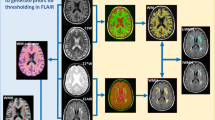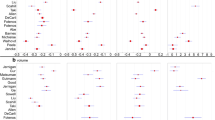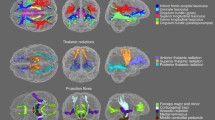Abstract
Objective
Cerebral atrophy and white matter lesions (WMLs) are common in older people with common risk factors, but it is unclear if they are related. We investigated whether and to what degree they are related in deep and superficial structures using both volumetric and visual ratings.
Methods
The intracranial, total brain tissue (TBV), cerebrospinal fluid (CSF), ventricular superficial subarachnoid space (SSS), grey matter, normal-appearing white matter, WMLs, and combined CSF, venous sinuses and dural volumes were measured. WMLs were also rated using the Fazekas scale.
Results
Amongst 672 adults (mean age 73 ± 1 years), WMLs were associated with global brain atrophy (TBV, β = −0.43 mm3, P < 0.01) and specifically with deep (ventricular enlargement, β = 0.10 mm3, P = 0.03) rather than superficial (SSS, β = 0.09 mm3, P = 0.55) atrophy. A 1 mm3 increase in WML volume was associated with a 0.43 mm3 decrease in TBV and 0.10 mm3 increase in ventricular volume. WMLs were associated with combined CSF + Venous Sinuses + Meninges volumes, but not CSF volume alone. Some of the associations were attenuated after correcting for vascular risk factors. The associations were similar for visually scored WMLs.
Conclusion
WMLs are associated with brain atrophy, primarily with deep brain structures. Measures of brain atrophy should include all intracranial structures when assessing brain shrinkage.
Key Points
• Increasing age-related white matter lesions (WML) are modestly associated with brain atrophy.
• Most associated atrophy affects deep structures (white matter, basal ganglia, etc.).
• This is true whether WMLs are assessed volumetrically or visually scored.
• Precise evaluation of brain atrophy requires assessment of all intracranial tissues.



Similar content being viewed by others
References
Muller M, Appelman A, van der Graaf Y, Vincken K, Mali W, Geerlings M (2011) Brain atrophy and cognition: interaction with cerebrovascular pathology? Neurobiol Aging 32:885–893
Resnick SM, Pham DL, Kraut MA, Zonderman AB, Davatzikos C (2003) Longitudinal magnetic resonance imaging studies of older adults: a shrinking brain. J Neurosci 23:3295–3301
Evans MC, Barnes J, Nielsen C et al (2010) Volume changes in Alzheimer’s disease and mild cognitive impairment: cognitive associations. Eur Radiol 20:674–682. doi:10.1007/s00330-009-1581-5
Kakeda S, Korogi Y, Yoneda T et al (2011) A novel tract imaging technique of the brainstem using phase difference enhanced imaging: normal anatomy and initial experience in multiple system atrophy. Eur Radiol 21:2202–2210. doi:10.1007/s00330-011-2158-7
Appelman APA, Exalto LG, van der Graaf Y, Biessels GJ, Mali W, Geerlings MI (2009) White matter lesions and brain atrophy: more than shared risk factors? A systematic review. Cerebrovasc Dis 28:227–242
den Heijer T, Geerlings MI, Hoebeek FE, Hofman A, Koudstaal PJ, Breteler MMB (2006) Use of hippocamal and amygdalar volumes on magnetic resonance imaging to predict dementia in cognitively intact elderly people. Arch Gen Psychiatry 63:57–62
Mok V, Wong KK, Xiong YY et al (2011) Cortical and frontal atrophy are associated with cognitive impairment in age-related confluent white-matter lesion. J Neurol Neurosurg Psychiatry 82:52–57
Koedam ELGE, Lehmann M, van der Flier WM et al (2011) Visual assessment of posterior atrophy development of a MRI rating scale. Eur Radiol 21:2618–2625. doi:10.1007/s00330-011-2205-4
Jokinen H, Lipsanen J, Schmidt R et al (2012) Brain atrophy accelerates cognitive decline in cerebral small vessel disease The LADIS study. Neurology 78:1785–1792. doi:10.1212/WNL.0b013e3182583070
Schmidt R, Grazer A, Enzinger C et al (2011) MRI-detected white matter lesions: do they really matter? J Neural Transm 118
Longstreth WT, Arnold AM, Manolio TA et al (2000) Clinical correlates of ventricular and sulcal size on cranial magnetic resonance imaging of 3,301 elderly people—The cardiovascular health study. Neuroepidemiology 19:30–42
Debette S, Markus H (2010) The clinical importance of white matter hyperintensities on brain magnetic resonance imaging: systematic review and meta-analysis. BMJ 26
van der Flier WM, van Straaten ECW, Barkhof F et al (2005) Small vessel disease and general cognitive function in nondisabled elderly—The LADIS study. Stroke 36:2116–2120
Prins ND, van Dijk EJ, den Heijer T et al (2005) Cerebral small-vessel disease and decline in information processing speed, executive function and memory. Brain 128:2034–2041
Raji CA, Lopez OL, Kuller LH et al (2012) White matter lesions and brain gray matter volume in cognitively normal elders. Neurobiol Aging 33:834.e837–834.e816
Liou L-M, Chen C-F, Guo Y-C et al (2010) Cerebral white matter hyperintensities predict functional stroke outcome. Cerebrovasc Dis 29:22–27
DeCarli C, Murphy DGM, Tranh M et al (1995) The effect of white-matter hyperintensity volume on brain structure, cognitive performance, and cerebral metabolism of glucose in 51 healthy-adults. Neurology 45:2077–2084
Breteler MMB, Vanswieten JC, Bots ML et al (1994) Cerebral white matter lesions, vascular risk-factors, and cognitive functions in a population-based study—The Rotterdam study. Neurology 44:1246–1252
Yue NC, Arnold AM, Longstreth WT et al (1997) Sulcal, ventricular, and white matter changes at MR imaging in the aging brain: data from the Cardiovascular Health Study. Radiology 202:33–39
Mosley TH, Knopman DS, Catellier DJ et al (2005) Cerebral MRI findings and cognitive functioning—The atherosclerosis risk in communities study. Neurology 64:2056–2062
Christiansen P, Larsson HBW, Thomsen C, Wieslander SB, Henriksen O (1994) Age-dependent white-matter lesions and brain volume changes in healthy-volunteers. Acta Radiol 35:117–122
Agartz I, Marions O, Saaf J, Wahlund LO, Wetterberg L (1992) Visual rating of magnetic-resonance images of human cerebrospinal-fluid spaces and white brain matter—relation to sex and age in healthy-volunteers. Magn Reson Imaging 10:135–142
Fazekas F, Barkhof F, Wahlund LO et al (2002) CT and MRI rating of white matter lesions. Cerebrovasc Dis 13:31–36
Kapeller P, Schmidt R, Enzinger C, Ropele S, Fazekas F (2002) CT and MRI rating of white matter changes. J Neural Transm Suppl 62:41–45
Scheltens P, Erkinjunti T, Leys D et al (1998) White matter changes on CT and MRI: an overview of visual rating scales. Eur Neurol 39:80–89
Ikram MA, Vrooman HA, Vernooij MW et al (2008) Brain tissue volumes in the general elderly population—The Rotterdam Scan Study. Neurobiol Aging 29:882–890
Swan GE, DeCarli C, Miller BL, Reed T, Wolf PA, Carmelli D (2000) Biobehavioral characteristics of nondemented older adults with subclinical brain atrophy. Neurology 54:2108–2114
Deary IJ, Gow AJ, Taylor MD et al (2007) The Lothian Birth Cohort 1936: a study to examine influences on cognitive ageing from age 11 to age 70 and beyond. BMC Geriatr 7:28
Wardlaw JM, Bastin ME, Hernandez MCV et al (2011) Brain aging, cognition in youth and old age and vascular disease in the Lothian Birth Cohort 1936: rationale, design and methodology of the imaging protocol. Int J Stroke 6:547–559
Jenkinson M, Smith S (2001) A global optimisation method for robust affine registration of brain images. Med Image Anal 5:143–156
Hernandez MDV, Ferguson KJ, Chappell FM, Wardlaw JM (2010) New multispectral MRI data fusion technique for white matter lesion segmentation: method and comparison with thresholding in FLAIR images. Eur Radiol 20:1684–1691
Mayo C (2008) Analyze 8.1. AnalyzeDirect, Inc. Mayo Clinic. http://www.analyzedirect.com/Analyze/upgrade.asp
Fazekas F, Chawluk JB, Alavi A, Hurtig HI, Zimmerman RA (1987) MR signal abnormalities at 1.5-t in alzheimer dementia and normal aging MR. Am J Roentgenol 149:351–356
Wardlaw, Ferguson KJ, Graham C (2004) White matter hyperintensities and rating scales—observer reliability varies with lesion load. J Neurol 251:584–590
Piguet O, Double KL, Kril JJ et al (2009) White matter loss in healthy ageing: a postmortem analysis. Neurobiol Aging 30:1288–1295
Longstreth WT, Manolio TA, Arnold A et al (1996) Clinical correlates of white matter findings on cranial magnetic resonance imaging of 3301 elderly people—The cardiovascular health study. Stroke 27:1274–1282
Ylikoski A, Erkinjuntti T, Raininko R, Sarna S, Sulkava R, Tilvis R (1995) White-matter hyperintensities on MRI in the neurologically nondiseased elderly—analysis of cohorts of consecutive subjects aged 55 to 85 years living at home. Stroke 26:1171–1177
Grau-Olivares M, Arboix A, Junque C, Arenaza-Urquijo EM, Rovira M, Bartres-Faz D (2010) Progressive gray matter atrophy in lacunar patients with vascular mild cognitive impairment. Cerebrovasc Dis 30:157–166
Chowdhury MH, Nagai A, Bokura H, Nakamura E, Kobayashi S, Yamaguchi S (2011) Age-related changes in white matter lesions, hippocampal atrophy, and cerebral microbleeds in healthy subjects without major cerebrovascular risk factors. J Stroke Cerebrovasc Dis 20:302–309
van den Heuvel DMJ, ten Dam VH, de Craen AJM et al (2006) Measuring longitudinal white matter changes: Comparison of a visual rating scale with a volumetric measurement. Am J Neuroradiol 27:875–878
Raz N (2004) The aging brain observed in vivo: Differential changes and their modifiers. In: Cabeza R, Nyberg L, Park DC (eds) Cognitive neuroscience of aging: Linking cognitive and cerebral aging. Oxford University Press, New York, pp 17–55
Raz N, Kennedy KM (2009) A systems approach to age-related change: Neuroanatomical changes, their modifiers, and cognitive correlates. In: Jagust W, D’Esposito M (eds) Imaging the aging brain. Oxford University Press, New York, pp 43–70
Appelman APA, Vincken KL, van der Graaf Y et al (2010) White matter lesions and lacunar infarcts are independently and differently associated with brain atrophy: the SMART-MR study. Cerebrovasc Dis 29:28–35
Du AT, Schuff N, Chao LL et al (2005) White matter lesions are associated with cortical atrophy more than entorhinal and hippocampal atrophy. Neurobiol Aging 26:553–559. doi:10.1016/j.neurobiolaging.2004.05.002
Mungas D, Jagust WJ, Reed BR et al (2001) MRI predictors of cognition in subcortical ischemic vascular disease and Alzheimer’s disease. Neurology 57:2229–2235
Tullberg M, Fletcher E, DeCarli C et al (2004) White matter lesions impair frontal lobe function regardless of their location. Neurology 63:246–253
Ashburner J, Friston K (2005) Unified segmentation. NeuroImage 26:839
Fischl B, van der Kouwe A, Destrieux C et al (2004) Automatically parcellating the human cerebral cortex. Cereb Cortex 14:11–22. doi:10.1093/cercor/bhg087
Smith SM (2002) Fast robust automated brain extraction. Hum Brain Mapp 17:143–155
Acknowledgments
BSA, NAR, SMM and MCVH are supported by The Disconnected Mind (http://www.disconnectedmind.ed.ac.uk/) funded by Age UK and the UK Medical Research Council. JMW was supported by the Scottish Funding Council (SFC) through the SINAPSE Collaboration (Scottish Imaging Network. A Platform for Scientific Excellence, http://www.sinapse.ac.uk). MCVH is also supported by Row Fogo Charitable Trust. We thank the radiographers and administrative staff of the Brain Research Imaging Centre, Edinburgh, (http://www.bric.ed.ac.uk/), part of the SINAPSE Collaboration (http://www.sinapse.ac.uk/), where the subjects were scanned and the imaging data were analysed. We thank the Lothian Birth Cohort 1936 team for data collection and data entry; the nurses and other staff at the Wellcome Trust Clinical Research Facility (http://www.wtcrf.ed.ac.uk/) and the staff at Lothian Health Board. The work was undertaken within The University of Edinburgh Centre for Cognitive Ageing and Cognitive Epidemiology (http://www.ccace.ed.ac.uk/), part of the cross council Lifelong Health and Wellbeing Initiative (G0700704/84698). Funding from the Biotechnology and Biological Sciences Research Council (BBSRC), Engineering and Physical Sciences Research Council (EPSRC), Economic and Social Research Council (ESRC) and Medical Research Council (MRC) is gratefully acknowledged.
Author information
Authors and Affiliations
Corresponding author
Electronic supplementary material
Below is the link to the electronic supplementary material.
ESM 1
(DOC 36 kb)
Rights and permissions
About this article
Cite this article
Aribisala, B.S., Valdés Hernández, M.C., Royle, N.A. et al. Brain atrophy associations with white matter lesions in the ageing brain: the Lothian Birth Cohort 1936. Eur Radiol 23, 1084–1092 (2013). https://doi.org/10.1007/s00330-012-2677-x
Received:
Revised:
Accepted:
Published:
Issue Date:
DOI: https://doi.org/10.1007/s00330-012-2677-x




